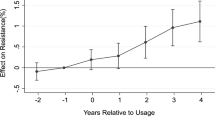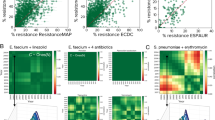Abstract
Antimicrobial resistance is an emerging public-health threat. Studies of the relationship between antibiotic use and resistance, as well as surveillance programmes, examine changes in the proportion of isolates that are resistant. Although proportions are helpful to the clinician prescribing empirical therapy, proportion-based analyses can be misleading to the public-health professional as they can yield biased estimates. Proportions do not adequately reflect the burden of resistance, a measure often of interest in public health. A more appropriate measure of this burden is the rate of isolation of resistant organisms, that is, the absolute number of resistant isolates in a population over time.
This is a preview of subscription content, access via your institution
Access options
Subscribe to this journal
Receive 12 print issues and online access
$209.00 per year
only $17.42 per issue
Buy this article
- Purchase on Springer Link
- Instant access to full article PDF
Prices may be subject to local taxes which are calculated during checkout

Similar content being viewed by others
References
NNIS system. National nosocomial infections surveillance (NNIS) system report, data summary from January 1992 through June 2003, issued August 2003. Am. J. Infect. Control 31, 481–98 (2003).
Buchholz, U., Bronzwaer, S. L., Schrijnemakers, P., Monen, J. & Kool, J. L. EARSS activities and results: update. Euro Surveill. 6, 2–5 (2001).
Gordon, K. A. & Jones, R. N. Susceptibility patterns of orally administered antimicrobials among urinary tract infection pathogens from hospitalized patients in North America: comparison report to Europe and Latin America. Results from the SENTRY antimicrobial surveillance program (2000). Diagn. Microbiol. Infect. Dis. 45, 295–301 (2003).
Cosgrove, S. E., Kaye, K. S., Eliopoulous, G. M. & Carmeli, Y. Health and economic outcomes of the emergence of third-generation cephalosporin resistance in Enterobacter species. Arch. Intern. Med. 162, 185–190 (2002).
Cosgrove, S. E. et al. Comparison of mortality associated with methicillin-resistant and methicillin-susceptible Staphylococcus aureus bacteremia: a meta-analysis. Clin. Infect. Dis. 36, 53–59 (2003).
Kuti, J. L., Nightingale, C. H. & Nicolau, D. P. Optimizing pharmacodynamic target attainment using the MYSTIC antibiogram: data collected in North America in 2002. Antimicrob. Agents Chemother. 48, 2464–2470 (2004).
Felmingham, D. The need for antimicrobial resistance surveillance. J. Antimicrob. Chemother. 50 (Suppl.), S1–S7 (2002).
Kaye, K. S., Engemann, J. J., Mozaffari, E. & Carmeli, Y. Reference group choice and antibiotic resistance outcomes. Emerg. Infect. Dis. 10, 1125–1128 (2004).
Livermore, D. M. et al. Trends in fluoroquinolone (ciprofloxacin) resistance in enterobacteriaceae from bacteremias, England and Wales, 1990–1999. Emerg. Infect. Dis. 8, 473–478 (2002).
Zervos, M. J. et al. Relationship between fluoroquinolone use and changes in susceptibility to fluoroquinolones of selected pathogens in ten United States teaching hospitals, 1991–2000. Clin. Infect. Dis. 37, 1643–1648 (2003).
Fridkin, S. K. et al. Monitoring antimicrobial use and resistance: comparison with a national benchmark on reducing vancomycin use and vancomycin-resistant enterococci. Emerg. Infect. Dis. 8, 702–707 (2002).
Bronzwaer, S. L. et al. A European study on the relationship between antimicrobial use and antimicrobial resistance. Emerg. Infect. Dis. 8, 278–282 (2002).
Harbarth, S., Albrich, W., Goldmann, D. A. & Huebner, J. Control of multiply resistant cocci: do international comparisons help? Lancet Infect. Dis. 1, 251–261 (2001).
Neuhauser, M. M. et al. Antibiotic resistance among Gram-negative bacilli in US intensive care units: implications for fluoroquinolone use. JAMA 289, 885–888 (2003).
Gentry, C., Flournoy, D. J. & Reinert, R. Analysis of antimicrobial resistance among Gram-negative bacilli and antimicrobial use in intensive care unit patients for 5 years in a Veterans Affairs medical center. Am. J. Infect. Control 30, 411–416 (2002).
Ernst, E. J. et al. Are United States hospitals following national guidelines for the analysis and presentation of cumulative antimicrobial susceptibility data? Diagn. Microbiol. Infect. Dis. 49, 141–145 (2004).
Bodey, G. P., Jadeja, L. & Elting, L. Pseudomonas bacteremia. Retrospective analysis of 410 episodes. Arch. Intern. Med. 145, 1621–1629 (1985).
Ibrahim, E. H., Sherman, G., Ward, S., Fraser, V. J. & Kollef, M. H. The influence of inadequate antimicrobial treatment of bloodstream infections on patient outcomes in the ICU setting. Chest 118, 146–155 (2000).
Harbarth, S. et al. Inappropriate initial antimicrobial therapy and its effect on survival in a clinical trial of immunomodulating therapy for severe sepsis. Am. J. Med. 115, 529–535 (2003).
Baquero, F. & Campos, J. The tragedy of the commons in antimicrobial chemotherapy. Rev. Esp. Quimioter. 16, 11–13 (2003).
NCCLS. Analysis and presentation of cumulative antimicrobial susceptibility test data; approved guidelines. NCCLS document M39-A (NCCLS, Philadelphia, 2002).
Pfaller, M. A., Jones, R. N., Doern, G. V. & Kugler, K. Bacterial pathogens isolated from patients with bloodstream infection: frequencies of occurrence and antimicrobial susceptibility patterns from the SENTRY antimicrobial surveillance program (United States and Canada, 1997). Antimicrob. Agents Chemother. 42, 1762–1770 (1998).
Jones, R. N. MYSTIC (meropenem yearly susceptibility test information collection) conference. Hamburg, Germany, 10 May 2001. Diagn. Microbiol. Infect. Dis. 41, 169 (2001).
Jacobs, M. R., Felmingham, D., Appelbaum, P. C. & Gruneberg, R. N. The Alexander Project 1998–2000: susceptibility of pathogens isolated from community-acquired respiratory tract infection to commonly used antimicrobial agents. J. Antimicrob. Chemother. 52, 229–246 (2003).
Cornaglia, G. et al. European recommendations for antimicrobial resistance surveillance. Clin. Microbiol. Infect. 10, 349–383 (2004).
Morabia, A. On the origin of Hill's causal criteria. Epidemiology 2, 367–369 (1991).
Rahal, J. J. et al. Class restriction of cephalosporin use to control total cephalosporin resistance in nosocomial Klebsiella. JAMA 280, 1233–1237 (1998).
Harbarth, S. et al. Effect of delayed infection control measures on a hospital outbreak of methicillin-resistant Staphylococcus aureus. J. Hosp. Infect. 46, 43–49 (2000).
Wisplinghoff, H. et al. Nosocomial bloodstream infections in US hospitals: analysis of 24,179 cases from a prospective nationwide surveillance study. Clin. Infect. Dis. 39, 309–317 (2004).
Jones, M. E. et al. Emerging resistance among bacterial pathogens in the intensive care unit — a European and North American Surveillance study (2000–2002). Ann. Clin. Microbiol. Antimicrob. 3, 14 (2004).
Fridkin, S. K. & Gaynes, R. P. Antimicrobial resistance in intensive care units. Clin. Chest Med. 20, 303–316 (1999).
Cook, P. P., Catrou, P. G., Christie, J. D., Young, P. D. & Polk, R. E. Reduction in broad-spectrum antimicrobial use associated with no improvement in hospital antibiogram. J. Antimicrob. Chemother. 53, 853–859 (2004).
Last, J. M. (ed.) A Dictionary of Epidemiology, 3rd edition 140 (Oxford Univ. Press, New York, 1995).
Lipsitch, M., Bergstrom, C. T. & Levin, B. R. The epidemiology of antibiotic resistance in hospitals: paradoxes and prescriptions. Proc. Natl Acad. Sci. USA 97, 1938–1943 (2000).
McCormick, A. W. et al. Geographic diversity and temporal trends of antimicrobial resistance in Streptococcus pneumoniae in the United States. Nature Med. 9, 424–430 (2003).
Krcmery, V. & Barnes, A. J. Non-albicans Candida spp. causing fungaemia: pathogenicity and antifungal resistance. J. Hosp. Infect. 50, 243–260 (2002).
Regev-Yochay, G. et al. Association between carriage of Streptococcus pneumoniae and Staphylococcus aureus in children. JAMA 292, 716–720 (2004).
Mendes, C. & Turner, P. J. Unit differences in pathogen occurrence arising from the MYSTIC program European database (1997–2000). Diagn. Microbiol. Infect. Dis. 41, 191–196 (2001).
Oteo, J., Baquero, F., Vindel, A. & Campos, J. Antibiotic resistance in 3,113 blood isolates of Staphylococcus aureus in 40 Spanish hospitals participating in the European antimicrobial resistance surveillance system (2000–2002). J. Antimicrob. Chemother. 53, 1033–1038 (2004).
Author information
Authors and Affiliations
Corresponding author
Ethics declarations
Competing interests
The authors declare no competing financial interests.
Related links
Related links
DATABASES
Entrez
FURTHER INFORMATION
Rights and permissions
About this article
Cite this article
Schwaber, M., De-Medina, T. & Carmeli, Y. Epidemiological interpretation of antibiotic resistance studies – what are we missing?. Nat Rev Microbiol 2, 979–983 (2004). https://doi.org/10.1038/nrmicro1047
Issue Date:
DOI: https://doi.org/10.1038/nrmicro1047
This article is cited by
-
Novel blaCTX-M variants and genotype-phenotype correlations among clinical isolates of extended spectrum beta lactamase-producing Escherichia coli
Scientific Reports (2019)
-
Surveillance of Gram-negative bacteria: impact of variation in current European laboratory reporting practice on apparent multidrug resistance prevalence in paediatric bloodstream isolates
European Journal of Clinical Microbiology & Infectious Diseases (2017)
-
MRSA prevalence in european healthcare settings: a review
BMC Infectious Diseases (2011)
-
Fluoroquinolone use is not associated with the change in imipenem susceptibility of Pseudomonas aeruginosa in 25 hospitals
Advances in Therapy (2011)
-
Impact of restriction of third generation cephalosporins on the burden of third generation cephalosporin resistant K. pneumoniae and E. coli in an ICU
Intensive Care Medicine (2009)



